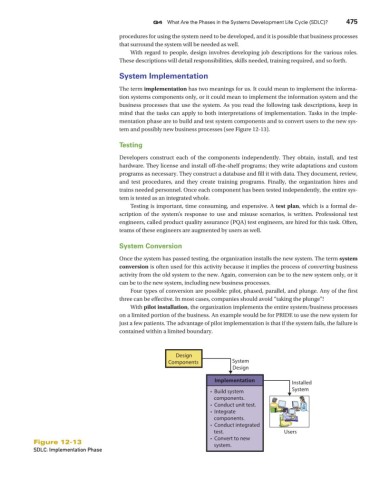Page 507 - Using MIS
P. 507
Q4 What Are the Phases in the Systems Development Life Cycle (SDLC)? 475
procedures for using the system need to be developed, and it is possible that business processes
that surround the system will be needed as well.
With regard to people, design involves developing job descriptions for the various roles.
These descriptions will detail responsibilities, skills needed, training required, and so forth.
System Implementation
The term implementation has two meanings for us. It could mean to implement the informa-
tion systems components only, or it could mean to implement the information system and the
business processes that use the system. As you read the following task descriptions, keep in
mind that the tasks can apply to both interpretations of implementation. Tasks in the imple-
mentation phase are to build and test system components and to convert users to the new sys-
tem and possibly new business processes (see Figure 12-13).
Testing
Developers construct each of the components independently. They obtain, install, and test
hardware. They license and install off-the-shelf programs; they write adaptations and custom
programs as necessary. They construct a database and fill it with data. They document, review,
and test procedures, and they create training programs. Finally, the organization hires and
trains needed personnel. Once each component has been tested independently, the entire sys-
tem is tested as an integrated whole.
Testing is important, time consuming, and expensive. A test plan, which is a formal de-
scription of the system’s response to use and misuse scenarios, is written. Professional test
engineers, called product quality assurance (PQA) test engineers, are hired for this task. Often,
teams of these engineers are augmented by users as well.
System Conversion
Once the system has passed testing, the organization installs the new system. The term system
conversion is often used for this activity because it implies the process of converting business
activity from the old system to the new. Again, conversion can be to the new system only, or it
can be to the new system, including new business processes.
Four types of conversion are possible: pilot, phased, parallel, and plunge. Any of the first
three can be effective. In most cases, companies should avoid “taking the plunge”!
With pilot installation, the organization implements the entire system/business processes
on a limited portion of the business. An example would be for PRIDE to use the new system for
just a few patients. The advantage of pilot implementation is that if the system fails, the failure is
contained within a limited boundary.
Design
Components System
Design
Implementation Installed
• Build system System
components.
• Conduct unit test.
• Integrate
components.
• Conduct integrated
test. Users
• Convert to new
Figure 12-13 system.
SDLC: Implementation Phase

